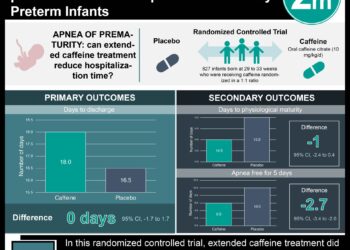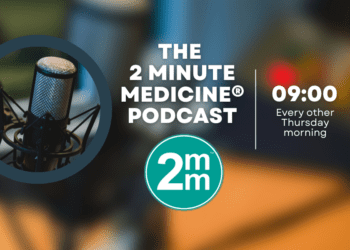Cerclage prevents recurrent preterm birth in women with short cervix [Classics Series]
1. In women with a history of prior preterm birth less and midtrimester cervical length <25mm, cerclage reduced perinatal morbidity and preterm delivery at less than 24 weeks.
2. In women with midtrimester cervical length <15mm, cerclage reduced preterm birth less than 35 weeks.
Original date of publication: October 2009
Study Rundown: Spontaneous preterm birth is a syndrome comprising preterm labor, preterm premature rupture of membranes and cervical insufficiency. Cervical insufficiency (CI), a clinical diagnosis, is characterized by painless cervical dilation and spontaneous midtrimester birth. It affects anywhere from 1 in 100 to 1 in 2000 women and its treatment is one of the most vexing problems in clinical obstetrics. An inverse relationship between midtrimester cervical length and risk of preterm birth is well-documented in the literature (background reading). Yet, the exact mechanisms by which inflammation or infection impairs the normal physiology of the pregnant cervix is not known such that existing treatments for CI, including cerclage, are largely empirically based.
Cerclage placement may be history-indicated (prophylactic), ultrasound-indicated or physical-exam indicated. Selecting appropriate candidates for prophylactic (history-indicated) cerclage is a challenge and some experts even argue that cerclage should not be placed for this indication. Multiple research studies fail to demonstrate benefit to cerclage placement in women without a history of prior spontaneous preterm birth but with a short cervix or with numerous risk factors for preterm birth. However, other studies demonstrate benefit to cerclage placement in women with a history of prior spontaneous preterm birth with a single gestation pregnancy (see background reading).
Researchers evaluated the benefit of cerclage placement in reducing preterm birth among women with a history of spontaneous preterm birth and a sonographically short cervix and found that prophylactic cerclage reduced the incidence of spontaneous preterm birth before 24 weeks gestation and perinatal mortality. Strengths of this study included randomized, multicenter design and serial sonographic cervical length examinations. Limitations included lack of blinding, which would have required performing sham surgery in those women randomized to the control group. The use of perioperative prophylactic antibiotics and tocolytic medications was not studied and use of progesterone supplementation was unable to be separately assessed.
Click to read the study in AJOG
Background reading: The role of cervical cerclage in obstetric practice, Cerclage for short cervix on ultrasound: Meta-Analysis
Dr. Alan Peaceman, MD, talks to 2 Minute Medicine: Northwestern University School of Medicine; Chief, Division of Obstetrics and Gynecology-Maternal Fetal Medicine.
“This multicenter randomized trial assessed the benefit of cerclage placement in a population of women with prior spontaneous preterm birth before 34 weeks’ gestation and transvaginal cervical length (TVCL) <25mm in the mid-trimester. The primary outcome of delivery before 35 weeks was no different between the groups, but cerclage was associated with reduced preterm delivery prior to 24 weeks, and also lowered perinatal mortality. Further, among women with TVCL <15mm, preterm delivery prior to 35 weeks was observed with cerclage. The findings identify a population of women who may benefit from cerclage in reducing fetal morbidity and mortality.”
In-Depth [multicenter randomized trial]: 302 women were randomized to receive McDonald cerclage (n=148) or no cerclage (n=153). Women with fetal anomalies, planned history-indicated cerclage placement and those with high-risk issues that might increase risk of indicated preterm birth (e.g. chronic hypertension) or disallow cerclage placement (e.g. complete placenta previa) were excluded. Participants underwent serial transvaginal ultrasounds q2 weeks from 16 weeks through 21 weeks 6 days gestation and were eligible for randomization if their cervical length was ever < 25mm and sterile vaginal and speculum exams ruled out acute cervical insufficiency, defined as cervical dilation of at least 2cm with visible membranes. Outcomes assessed included delivery prior to 35 completed weeks gestation, delivery prior to 24 completed weeks gestation and perinatal mortality, defined as stillbirth or postnatal death prior to hospital discharge.
Among women with a history of spontaneous preterm birth found to have a cervical length <25mm in the midtrimester, prophylactic cerclage reduced the incidences of spontaneous preterm birth before 24 weeks gestation (p=0.03) and perinatal mortality (p=0.46). In women with a midtrimester cervical length <15mm, cerclage placement reduced the incidence of spontaneous preterm birth before 35 weeks (p<0.01). Among women with midtrimester cervical length <25mm, the primary outcome of preterm birth before 35 weeks did not significantly differ between cerclage and control groups (32% vs 42% respectively, p=0.09).
More from this author: Risks of trial of labor after cesarean delivery (TOLAC) [Classics Series], Recurrent pregnancy loss associated with increased cardiovascular morbidity, Home self sonograms for assisted reproduction comparable to in-office imaging, Induction of labor more successful with standardization, The TRINOVA-1 trial: trebananib decreases progression of recurrent ovarian cancer
Image: PD
©2012-2014 2minutemedicine.com. All rights reserved. No works may be reproduced without expressed written consent from 2minutemedicine.com. Disclaimer: We present factual information directly from peer reviewed medical journals. No post should be construed as medical advice and is not intended as such by the authors, editors, staff or by 2minutemedicine.com. PLEASE SEE A HEALTHCARE PROVIDER IN YOUR AREA IF YOU SEEK MEDICAL ADVICE OF ANY SORT.






![[CORAL-1 trial] Interferon-free regimen for recurrent hepatitis C after liver transplant safe and effective](https://www.2minutemedicine.com/wp-content/uploads/2014/11/10229_lores-75x75.jpg)
